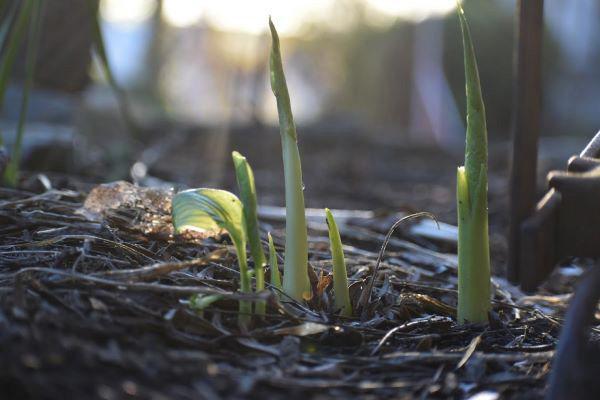Spring seemed to come late this year, with cool temperatures holding on in many areas of the country. Some of you let us know you still had snow in late April, and here in the Mid-Atlantic we’ve hardly had to turn on the air conditioning, as opposed to other years when we’ve had long 90 degree stretches in May.
Of course, that makes it a little more challenging to decide whether last year’s plantings are just slow to emerge or if they’ve done a disappearing act. That can be extremely difficult for new gardeners—many’s the time in my previous life I had customers returning plants that were still alive but just hadn’t started new growth yet. One thing to remember is that “perennial” doesn’t mean “forever,” it just means that the plant takes more than one year to complete its life cycle, unlike annuals that grow, bloom, set seed and perish all in one year.
Generally, short-lived perennials are considered those that live 3 to 5 years before they decline. Long-lived perennials can be expected to live 10 years or longer.
Some plants sold as perennials are biennials, growing foliage the first year and flowering the next, after which they’re kaput. Others may expire after as little as 3 years even with proper care. These may manage to reseed themselves, but that means you must not apply any weed preventer or accidentally remove them by mistaking them for a weed. Still others commonly enter dormancy in the summer, resulting in an annoying empty spot in your otherwise perfectly planned garden.
Rarely do plant tags explain any of this, so we thought we’d help out with a list of “not-so-perennial” perennials, late-emerging, summer dormant, and long-lived perennials. This knowledge can assist you in planning new plantings, whether filling in unfortunate new empty spaces in spring or designing new beds.
And hopefully it will help you determine if your plant is really expired before you try returning it—which I admit I did, too, as a newbie gardener. As a general rule, if you haven’t seen any new growth by a month to 6 weeks after your last frost date it’s probably not looking good.
Woody plants are the easiest ones to figure out, so there's less trouble with trees and shrubs. Although most popular perennials are herbaceous, sometimes things like butterfly bushes and tree peonies may be sold in a garden center's perennial department. Regardless of how it's categorized, a woody plant will be green under the bark if it is alive. Gently scratch the stem with your fingernail, starting at the top. Keep checking farther down the stem until you see the green underneath. Prune out anything above where the live wood appears, then watch and wait.
If there is no green even all the way down to the crown you may still want to wait—butterfly bushes, passionflower vines and others are known to return from the roots. It is the first week of June here and my passionflower (P. caerulea) is just now sending up new shoots, as well as sprouting from a bit of last year's stem. A week ago the shoots were only an inch high.
By this time, it should be fairly evident whether your plants are making a comeback or not, even ones that traditionally make a late appearance.
You might notice on the list below that most of shorter-lived perennials are long bloomers and the long-lived perennials tend to have a shorter season of bloom. That makes perfect botanical and biological sense--longer-lived plants are not tiring themselves out with reproduction--usually because a tap root or some other root adaptation provides their species endurance in a different fashion. Some of the shorter-lived perennials just need to be divided more frequently--in fact, some of these are considered both short and long-lived depending on the resource.
For example, most monarda and yarrow species are considered long lived, but can die out in the center of the plant. Digging up the clump, discarding the center portion and replanting the outer sections will rejuvenate these plants, and keep them where you want them. Perennials that have an extended blooming period, especially those that bloom into the fall can be aided by removing some of the buds late in the season. This will allow the plant to put more of its energy toward building a good root system and a full crown which will help it overwinter.
Perennials such as astilbe that can withstand wet soil in summer will not be so forgiving in dormancy. Most perennials other than bog plants will require well-drained soil over winter, so probably not a good place to pile your shoveled snow.
Knowing which plants sprout late or go dormant in summer can allow you to choose nearby plants that will fill in those areas--for instance, hostas are often planted near summer dormant bleeding hearts as their growing leaves will disguise the empty space.
The best design will incorporate both long and short-lived perennials, creating a garden with less maintenance overall while maximizing the flower power. One of the best resources for choosing your plants are the many plant trials run by universities and public gardens across the country. Whether online or in person, these can assist you in finding better cultivars. For instance, many of the newly bred thread-leaf coreopsis and non-purple Echinacea cultivars just don't seem to have the staying power the breeders would suggest. Consulting a trial in your general area will provide information the most relevant to your growing conditions. Below the chart is a list of several websites you might explore.
Let us know what is perennial--or not--for you. It's always interesting to share and learn from different experiences!
Click here for: List of Short-Lived, Long-Lived, & Summer Dormant Perennials and Biennials with notes and replacement suggestions
Links to Plant Trials:
University of Florida: Fort Lauderdale


